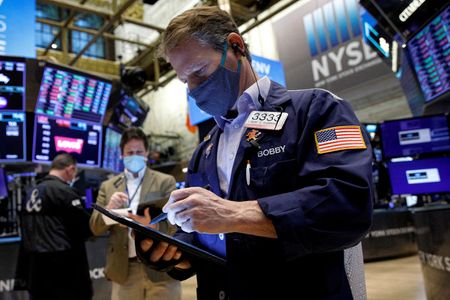
By Koh Gui Qing
NEW YORK (Reuters) – Nervous global stock markets floundered on Thursday as bond yields steadied and the dollar wilted, after the highest U.S. inflation reading in nearly 40 years kept concerns about price pressures and monetary policy risks alive.
Indeed, data released on Thursday that pointed to rapidly tightening U.S. labor market conditions presaged the supply bottlenecks and persistent inflation pressures that could come, unsettling investors already nervous about imminent rate hikes.
Further warnings from Fed Governor Lael Brainard on Thursday that “inflation is too high” and that controlling inflation is the “most important task” for the central bank kept investors focused on potential pitfalls ahead.
By early afternoon, MSCI’s gauge of stocks across the globe had shed 0.41%, as stocks in Europe and the United States slipped into the red.
The S&P 500 lost 0.64%, the Nasdaq Composite dropped 1.45%, and the Dow Jones Industrial Average was little changed.
The pan-European STOXX 600 index ended flat as losses in defensive stocks were matched by gains in automakers and technology stocks on hopes of improving semiconductor supply. [.EU]
“We do not think the returns from many financial assets will be as good in 2022 as they were in 2021,” said John Higgins, chief markets economist at Capital Economics.
“For a start, we envisage a sell-off in government bonds in most places, reflecting the outlook for monetary policy. And, in general, we foresee an underwhelming performance from equities, including in the United States and China.”
Data released on Wednesday had showed U.S. consumer price inflation bounding 7% on an annual basis in December, the highest since 1982. While the report was widely expected, it left intact investor bets that U.S. interest rates could rise as soon as March.
“As we see it, the inflation story is going to persist for a good while longer yet,” said Manulife Asset Management’s global macro strategist Eric Theoret.
“We have had a tremendous acceleration in the Fed’s tightening,” he added. Theoret pointed out that when the U.S. central bank raised interest rates in 2015, it waited two years before shrinking its balance sheet, whereas this time it could begin by the end of the year.
“The challenge from here is how the global economy responds to this normalization.”
In the bond markets, where borrowing costs have raced to keep up with rate hike expectations this year, 10-year U.S. Treasury yields hovered around 1.7200% and Germany’s 10-year yield bobbed near -0.086% having approached positive yield territory for the first time since May 2019.
European Central Bank Vice President Luis de Guindos became the latest to warn that the current spike in inflation was not going to be as transitory as originally expected. Upmarket Swiss bathroom goods giant Geberit had seen its shares slide too as it warned it was now impossible to predict how much raw materials prices would rise this year.
It is a busy period for bond issuance as countries and companies look to beat the rise in rates. Italy was due to sell up to 7 billion euros of three- and seven-year bonds later, and Ireland was eyeing a bumper sale. The week is also set to be a record one for emerging market corporate debt sales with nearly 30 taking place.
“It is a record in my time,” said Omotunde Lawal, head of emerging markets corporate debt at Barings. “Most people are swamped, but you can see why with as many as four Fed hikes now priced in.” (Graphic: global cbanks, https://fingfx.thomsonreuters.com/gfx/mkt/gdpzykbekvw/cbank%20sheet.JPG)
DOLLAR DOLDRUMS
In the currency markets, the dollar continued to slip toward a two-month low against a basket of currencies, with the dollar index down 0.214% at 94.803.
The euro was a big beneficiary of the move and was steady at $1.14615, up 0.18% on the day, while sterling and the yen also extended recent gains. [/FRX]
The pound is up more than 4% from December lows and traders have so far shrugged off a political crisis enveloping Prime Minister Boris Johnson, who apologized on Wednesday for attending a party at his official Downing Street residence in May 2020 during a coronavirus lockdown.
The central bank of New Zealand has begun hiking rates too, and the New Zealand dollar rallied 0.4% to $0.6878, its strongest since late November.
Australia’s dollar, which tends to perform well when broader market sentiment is improving, added 0.1% to $0.72915 .
The Canadian dollar has rallied more than 3.5% in three weeks, gaining with oil prices as investors look past the potential economic fallout of the Omicron variant.
“The (U.S.) dollar does not have to increase because the Fed is readying a tightening cycle,” said Commonwealth Bank of Australia strategist Joe Capurso.
“It is not a simple equation of Fed hikes equals dollar increases. The dollar is a counter-cyclical currency which decreases as the world economy recovers.”
In Asia, Chinese blue-chips dropped 1.6% after data showing mainland bank lending fell more than expected in December, causing property and consumption sectors to sink.
MSCI’s broadest index of Asia-Pacific shares outside Japan was flat after recording its biggest daily gain in a month on Wednesday. Japan’s Nikkei lost nearly 1% after surging nearly 2% a day earlier.
Oil prices ticked lower in commodity markets too, a day after hitting their highest in nearly two months. [O/R]
U.S. crude recently fell 0.36% to $82.34 per barrel and Brent was at $84.60, down 0.08% on the day.
A softer dollar did not bolster bullion prices, which were weighed down by the prospect of rising rates. Spot gold dropped 0.2% to $1,821.24 an ounce. [GOL/]
(Additional Reporting by Tommy Wilkes in London and Andrew Galbraith in Shanghai; Editing by Tomasz Janowski, Toby Chopra, Jonathan Oatis, Alexandra Hudson)

